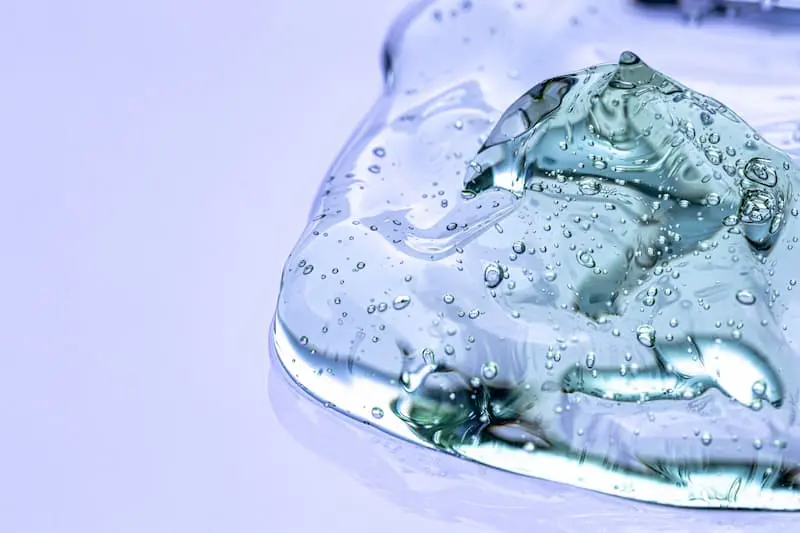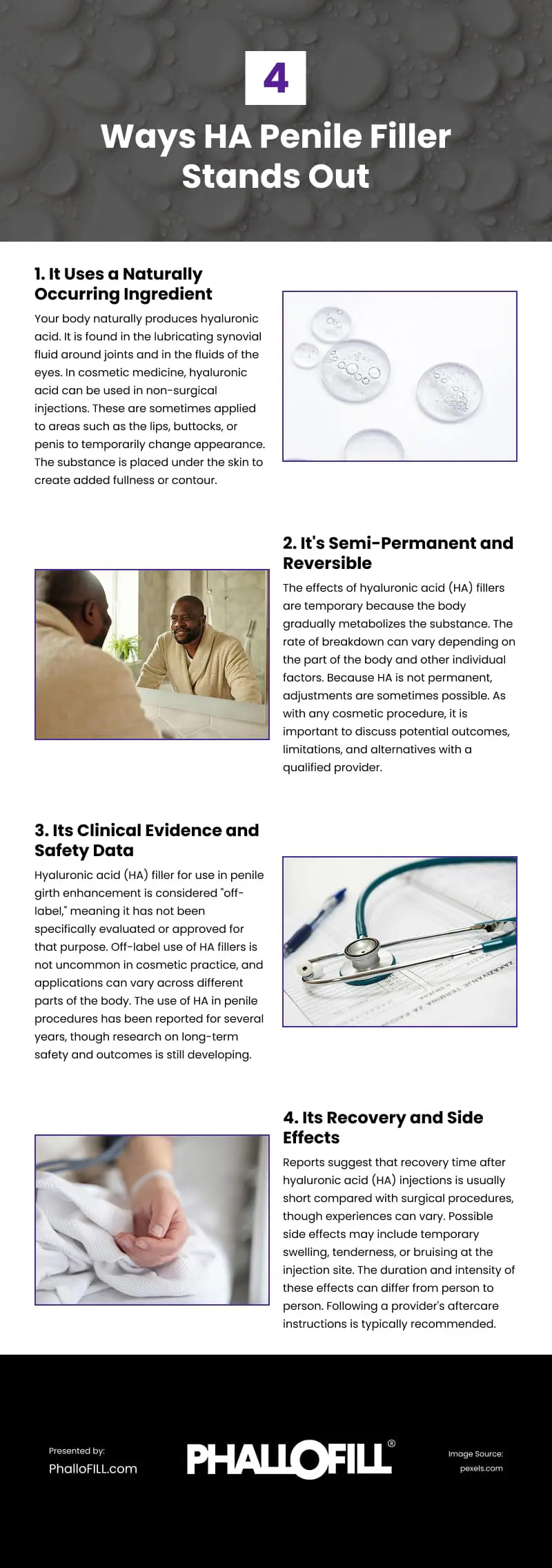Hyaluronic acid (HA) fillers are a cosmetic option sometimes used for penile girth enhancement. HA is a substance that occurs naturally in the body and has long been applied in other areas of cosmetic medicine, such as lip and facial fillers.
In recent years, some clinics have begun offering HA injections for penile enhancement. The procedure is non-surgical and generally involves placing HA under the skin of the penis to create a temporary increase in girth.
As with any cosmetic procedure, it’s important to understand the available research, potential risks, and individual considerations before deciding if this option is appropriate. This article provides background information on how HA fillers are used and what factors people often weigh when evaluating them.
What Makes HA Filler So Great?
It Uses a Naturally Occurring Ingredient
Your body naturally produces hyaluronic acid. It is found in the lubricating synovial fluid around joints and in the fluids of the eyes.
In cosmetic medicine, hyaluronic acid can be used in non-surgical injections. These are sometimes applied to areas such as the lips, buttocks, or penis to temporarily change appearance. The substance is placed under the skin to create added fullness or contour.
As with any cosmetic procedure, individual experiences can vary, and it is important to learn about the potential risks, limitations, and available research before considering treatment.
It’s Semi-Permanent and Reversible
The effects of hyaluronic acid (HA) fillers are temporary because the body gradually metabolizes the substance. The rate of breakdown can vary depending on the part of the body and other individual factors.
Some reports suggest that penile HA fillers may last longer than fillers in other areas, though the duration can differ widely between individuals.
Because HA is not permanent, adjustments are sometimes possible. A substance called hyaluronidase may be used in clinical settings to dissolve HA if needed.
As with any cosmetic procedure, it is important to discuss potential outcomes, limitations, and alternatives with a qualified provider.
Its Clinical Evidence and Safety Data
Hyaluronic acid (HA) filler for use in penile girth enhancement is considered “off-label,” meaning it has not been specifically evaluated or approved for that purpose.
Off-label use of HA fillers is not uncommon in cosmetic practice, and applications can vary across different parts of the body. The use of HA in penile procedures has been reported for several years, though research on long-term safety and outcomes is still developing.
For more proof, check out reputable information regarding the safety and efficacy1 of HA fillers in penile enhancement. Also, read up on the American Urological Association’s (AUA)2and the Sexual Medicine Society of North America’s (SMSNA)3 ongoing research.
Its Recovery and Side Effects
Reports suggest that recovery time after hyaluronic acid (HA) injections is usually short compared with surgical procedures, though experiences can vary. Some people return to daily activities soon after treatment, while others may need additional rest depending on individual response.
Possible side effects may include temporary swelling, tenderness, or bruising at the injection site. The duration and intensity of these effects can differ from person to person. Following a provider’s aftercare instructions is typically recommended.
Comparing HA Fillers to Other Enhancement Methods
Reversibility matters. The last thing you want is to be stuck with a look or feel you dislike down there. You have many surgical and non-surgical options available to enhance your member. Let’s look at a few of those.
The Surgical Route
Surgical methods include:
- Implants
- Fat grafting
- Suspensory ligament division
Silicone Implants
Silicone has sometimes been used in penile enhancement procedures, although this is considered an off-label application. Medical literature and regulatory agencies have raised concerns about complications associated with silicone implantation. Reported issues include inflammation, scarring, and other adverse reactions.
Because of these risks, silicone is not widely recommended for this purpose. Individuals considering enhancement procedures are generally advised to review the available evidence and discuss potential outcomes and alternatives with a qualified provider.
Fat Grafting
Fat grafting involves taking fat from another part of the body, such as the abdomen or thighs, and transferring it into the shaft of the penis. Reported outcomes can vary, and some accounts note changes in texture or appearance if the fat does not fully integrate.
Suspensory Ligament Division
Suspensory ligament division is a surgical procedure in which the ligament connecting the penis shaft to the pubic bone is cut. This can create the appearance of added length when the penis is flaccid, but it does not increase width. Some reports note that the ligament may reattach in ways that affect outcomes.
Like other surgical options, this procedure typically requires general or spinal anesthesia and a longer recovery period compared with non-surgical approaches. Surgical procedures are generally considered permanent and reversing them may not always be possible.
Non-Surgical Alternatives
We hear you: penis surgeries can be scary and expensive. So, here are non-surgical alternatives to HA penis fillers:
- Poly(methyl methacrylate) (PMMA)
- Silicone
- Calcium hydroxylapatite
- Manual and Mechanical Techniques
Poly(methyl methacrylate)
Poly(methyl methacrylate), or PMMA, is a synthetic material that has been used in certain medical applications, such as bone cementing and dental procedures. Its use in penile enhancement is considered off-label.
Reports in the literature note that outcomes and satisfaction rates vary, and complications have been documented. Because of these factors, PMMA remains a subject of debate in cosmetic practice.
Silicone Filler
Silicone is a material that has been used in various medical devices, such as tubing and masks. In some cases, it has also been used in filler form for cosmetic purposes.
Reports in the medical literature describe a range of outcomes, including complications. Because of these concerns, silicone fillers remain a controversial option in cosmetic practice.
Calcium Hydroxylapatite
Calcium hydroxylapatite is a filler commonly used in cosmetic medicine, particularly for facial and hand treatments. Its use in penile procedures is considered off-label.
Published reports note a range of outcomes when used for penile girth enhancement, and some accounts describe the formation of granulomas (firm nodules) as a possible complication. Because of these factors, calcium hydroxylapatite is generally approached with caution in this context.
Manual and Mechanical
Manual and mechanical techniques—such as jelqing, traction devices, weights, or vacuum pumps—are sometimes promoted for penile enhancement. However, published medical literature raises concerns about their safety and effectiveness, especially for girth enhancement. Reported risks include tissue injury and unsatisfactory outcomes.
The Sexual Medicine Society of North America (SMSNA) has compared these approaches with other surgical and non-surgical options. They note that hyaluronic acid (HA)–based fillers are non-permanent and reversible, which may offer advantages in terms of flexibility and risk management.
Finding Quality Providers
When exploring cosmetic filler options, it’s important to choose providers carefully. You might start by searching “penis filler near me” in your preferred browser. When reviewing providers, consider:
- Whether they share before-and-after examples of their work
- Positive feedback or independent reviews
- Clear communication about procedures, risks, and limitations
What a Professional Consultation May Involve
A professional consultation can give you an opportunity to:
- Discuss your reasons for considering fillers
- Ask whether fillers are suitable for your situation
- Learn about alternatives, including both surgical and non-surgical options
- Understand potential risks, side effects, and limitations
If your concerns relate to other issues (such as sexual performance or body image), a provider may suggest different or additional approaches.
So, be honest, raise any concerns, and have a candid conversation about what you hope to achieve from HA filler. While these fillers aren’t a catch-all solution, they may be an option for men whose self-esteem is affected by concerns about size or appearance.5
Informed Consent
A thorough consultation often involves a discussion of your expectations and concerns. This may include:
- Potential risks and side effects of HA fillers
- Possible benefits and limitations
- Typical aftercare instructions
The goal of this conversation is to help you make an informed decision before moving forward.
Recovery Info
HA has very little post-procedure recovery time compared to other procedures. Your provider should give you a written after-care protocol, to include the following information:
- No manual stimulation or sex for 7-14 days
- No heavy lifting
- Possible bruising that should disappear within days
HA Penis Fillers Are Safe and Effective
Here’s the bottom line: Hyaluronic acid fillers are a non-surgical and reversible penile enhancement procedure. If you’d like to learn more, you can search online for scientific publications about hyaluronic acid girth treatments and providers.
Infographic
Hyaluronic acid (HA) girth enhancement is gaining attention for its non-surgical, customizable approach to male cosmetic procedures. Learn how HA penile fillers stand out in this infographic.
1https://www.urologytimes.com/view/retrospective-review-shows-penile-girth-enhancement-fillers-induce-safe-outcomes
2https://www.auanews.net/issues/articles/2024/august-extra-2024/office-and-surgical-technologies-the-evolving-landscape-of-penile-girth-enhancement
3https://www.smsna.org/patients
4https://academic.oup.com/jsm/article/21/6/573/7656694
5https://doi.org/10.1093/asj/sjy108





